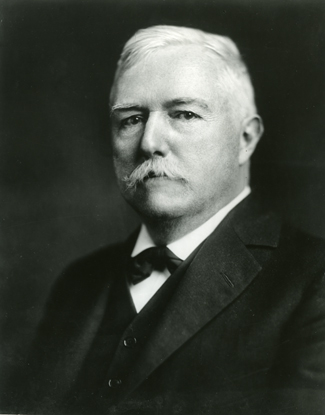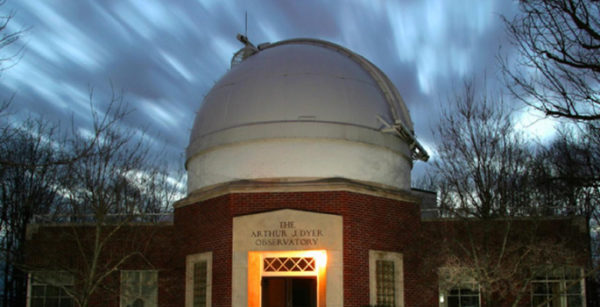Ask Billy Teets a question about the history of astronomy in Tennessee, and it’s more than likely he’ll know the answer. As the director of Vanderbilt’s Dyer Observatory, Teets is passionate about sharing his enthusiasm for the observatory through operating its telescopes and equipment, teaching college-level astronomy courses and serving as a regular speaker for the observatory’s public outreach events, camps, workshops and field trips.
He also enjoys featuring Tennessee’s important astronomers. This spring, Teets is celebrating the contributions of one of Vanderbilt’s most well-known figures—astronomer Edward Emerson Barnard, who died in 1923.
On Thursday, March 16, Teets will give a talk at Dyer Observatory’s monthly “Meet the Astronomer” lecture about Barnard’s life and accomplishments. The lecture will be at 7 p.m. at the Dyer Observatory, 1000 Oman Drive in Brentwood. The lecture will also be livestreamed via Zoom, and a link will be made available that day on the Dyer Observatory homepage. A lively Q&A session will follow the talk as well as a bit of viewing through Dyer Observatory’s Seyfert Telescope (if weather permits).
Teets connected with MyVU for a Q&A to discuss Barnard’s legacy and why the astronomer’s contributions still matter.
Q: Who was Edward Emerson Barnard?
A: Edward Emerson Barnard was a well-known observational astronomer. Barnard was born in 1857 and grew up in poverty. He had a fascination with the sky from a very young age and connected with Vanderbilt in early adulthood.
A year after admitting its first students in 1875, Vanderbilt established its first astronomical observatory as the second building to be erected on the growing campus, suggesting the high priority of the department for Vanderbilt’s first chancellor and for Professor of Physics and Astronomy Landon C. Garland.
The observatory was equipped with a six-inch aperture refracting telescope built by the firm of Thomas Cooke of York, England, and a four-inch Merz meridian circle telescope also acquired in Europe. Despite being well-equipped, the observatory did not have an astronomer and was not well utilized. In 1883, the university placed Nashville native Edward Emerson Barnard in charge of the observatory.

Q: What is notable about Mr. Barnard’s accomplishments at Vanderbilt?
A: Although Barnard lacked formal education and was only 25, his training in a local photography studio and his growing reputation as an amateur astronomer with several prize-winning discoveries to his name made the young Barnard the ideal candidate to oversee the observatory. Along with taking his first courses in mathematics, physics and foreign languages, Barnard furthered his astronomical research and made several key discoveries, including nine comets, a slew of double stars, and several new nebulae, during his career at Vanderbilt. Vanderbilt’s first annual appear in 1887 and was named The Comet in honor of Barnard’s work.
- In 1877, Barnard spent two-thirds of his annual salary on the purchase of a 5-inch refracting telescope, known as the Byrne refractor after its manufacturer. Barnard affectionately referred to it as his “pet,” and it would be used by him to make his first comet discoveries and a number of other discoveries while at Vanderbilt.
- Before being appointed to VU, Barnard recorded observations of Jupiter with hand-drawn sketches, which were submitted to and published by the “English Mechanic and World of Science.”
- He observed the transit of Mercury in 1878. As the disc of Mercury became visible in front of the solar disc, crossed and eventually exited, he recorded timings of key points of the transit, which were included in an official government report.
- Using his own telescope, Barnard discovered in 1884 what is now known as Barnard’s Galaxy, a dwarf galaxy that is part of the local galactic neighborhood known as the Local Group. It would be another 36 years before there was firm evidence that what we know as “galaxies” today were in fact outside of the Milky Way and that the Milky Way was just a galaxy itself and not the entire universe. Barnard’s Galaxy was the first object that Edwin Hubble, namesake of the Hubble Space Telescope, showed to be separate from the Milky Way, thus indicating that the Milky Way wasn’t the entirety of the universe.
- While at Vanderbilt, Barnard also independently discovered the gegenschein, a faint glow that we now know is the result of sunlight scattering off interplanetary dust particles. His observations of it over his career would reinvigorate interest in the phenomenon, spurring more research to its true cause.
Q: Mr. Barnard died on Feb. 6, 1923. Why Vanderbilt does make it a point to honor Mr. Barnard?
A: There are a couple of things we are doing this year to celebrate Barnard and his legacy. First, we do a monthly newsletter, “The Dyer Observer,” that has observatory updates, articles about astronomy topics, highlights certain objects in the “Image of the Month” and “Object of the month” sections, and more. For 2023, one of the sections is a monthly serial that goes through the life of Barnard. By December, we hope to have given a good “Cliff’s Notes” version of Barnard’s life and accomplishments. In addition, one of the main articles following the bio serial focuses on something discovered by Barnard. We are also trying to focus the “Image of the Month” and “Object on the Month” to things related to Barnard.
On Thursday, March 16, I will be giving a talk at Dyer Observatory’s monthly “Meet the Astronomer” lecture about Barnard’s life and accomplishments. I won’t be able to go over everything he did, but I will highlight a number of discoveries as we talk about his life.
Barnard was an incredible figure in the world of astronomy. His list of discoveries and accomplishments is truly remarkable, especially when you consider his very humble beginnings in poverty and virtually no education. He had a true love of the sky and universe that you rarely find today, even among some of the most renowned astronomers. He devoted his life to exploring the night sky and contributing to our understanding of the universe, and it all began right here in Nashville literally in his backyard. I think it’s important for the Nashville community to realize that a local figure made such a big splash.
Q: What is Mr. Barnard’s legacy in the astronomy world?
A: Barnard remains one of America’s most noted astronomers for his discovery of 16 comets, the fifth satellite of Jupiter (the first to be discovered since Galileo’s groundbreaking observations of Jupiter’s first four moons in 1610 and the last moon to be discovered by just looking into an eyepiece of a telescope) and Barnard’s Star (second-closest star system to our Sun and the star with the highest motion across our sky), as well as his successful application of photography to stellar astronomy (revealed structures unseen to the eye and showed photography to also be superior in accuracy versus sketching), his micrometer measurements of stellar positions and his research of dark nebulae. After Barnard’s departure from Vanderbilt, the university remained proud of its early association with E.E. Barnard. Although he never graduated Vanderbilt, Barnard received one of the only honorary academic degrees Vanderbilt has ever awarded.
Q: When was the Barnard Observatory established?
A: The Barnard Observatory, named by the Vanderbilt Board of Trust in 1942, began construction in 1875, was completed in 1876 and was eventually razed in 1952 and its telescopes placed in storage. The six-inch telescope, now known as the Barnard telescope, remained in storage until 1973, when it was installed in the dome of the Stevenson Center on the Vanderbilt University campus. Newly refurbished in 2007, the Barnard telescope is now at the Dyer Observatory. Bricks from the Barnard Observatory were used in the construction of the director’s residence at the Dyer site. The meridian circle telescope is in storage at Dyer Observatory, but there are plans to restore it and have it on exhibit in the near future. It should also be noted that these instruments, along with other bits of equipment, were part of the much larger collection of physics and astronomy instruments purchased by Chancellor Garland that are now collectively known as the Garland Collection. Dyer Observatory has the astronomy portion, and many other pieces are found in the Stevenson Science Building.

Q: How will Mr. Barnard’s influence shape the future of the observatory?
A: One of the first things that comes to mind is that during field trips (mostly elementary and middle school students), I always give a bit of history since the students first see the Garland Collection when they come through the front door of Dyer Observatory. During those few minutes, I give a brief story of Edward Barnard, highlighting how he started out with basically nothing but, by following his dream, became world famous and accomplished incredible things. I think it is important for children (or anyone) to realize that they have the power to shape their own destiny even it if seems like things may be impossible. Barnard did just that.